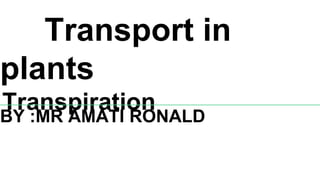
Lesson 1 bio.pptx
- 1. Transport in plants Transpiration BY :MR AMATI RONALD
- 2. Transpiration ❖ Transpiration is the physiological process where water is lost in the form of vapours from the aerial parts of plants. ❖Water is essential for plant to carry out almost all physiological processes but plant utilizes very small amount of water absorbed while as per modern physiology 99% of water absorbed by the roots is released in the form of vapours.
- 3. Transpiration Depending on the organ that performs transpiration, there are three types namely, 1.Stomatal Transpiration: It is loss of water through small specialized pores present on leaves known as ‘Stomata’. Maximum amount of water (Around 90%) is lost through stomata. 2.Cuticular Transpiration: Cuticle is an impermeable layer present on leaves and stem and around 8 to 10% of water is lost through cuticles. Cuticular transpiration is very less in xerophytes as they possess thick cuticles. 3.Lenticular Transpiration: Lenticels are tiny openings present on woody bark and water lost through lenticels is negligible (about 0.1 % to 1%).
- 4. Stomatal Transpiration ● Stomata are minute openings present in the epidermis of leaf. ● Each stoma consists of a stomatal pore which is surrounded by specialized cells termed as guard cells. ● Guard cells contain a nucleus, chloroplasts and a layer of cytoplasm with central vacuole filled with cell sap. ● The inner wall of guard cells is thick and non- elastic in nature whereas outer wall is thin and elastic. ● Guard cells are kidney shaped in dicots and dumb-bell shaped in monocots. ● Stomata are surrounded by subsidiary cells which play vital role in opening and closing of stomata
- 5. Opening and closing of stomata ● The opening and closing of stomata is popularly known as stomatal movement. ● This opening and closing of stomata is controlled by concentration of solutes in the guard cells. ● Guard cells have starch containing chloroplasts, during day time, pH of guard cells is neutral or slightly alkaline which favours the conversion of starch into sugar in the presence of inorganic phosphate with the help of enzyme phosphorylase. ● Sugar being soluble in water, increases the osmotic pressure of guard cells. As a result of this, guard cells absorb water from the mesophyll cells. Due to diffusion of water into guard cell, guard cells become turgid. ● As outer wall of guard cells is thin and elastic stomata gets open during day time.
- 6. Opening and closing of stomata…….. Continue ● During night time, CO2 is released in the guard cells but that is not utilized for photosynthesis. ● Due to release of CO2, the pH of guard cells become acidic (pH= 5.00). ● The acidity favours the conversion of sugar into starch. ● Starch is insoluble and osmotically inactive substance and therefore, osmotic potential of guard cells is decreased. ● As a result, water diffuses from the guard cells to mesophyll cells and stomata gets closed. pH = 7.5 pH = 5.00
- 8. In 1974, Levit proposed K-pump hypothesis for opening and closing of stomata. It is also known as ‘Theory of Proton Transport’ or ‘Active K+ transport mechanism’. Following are the key features of his hypothesis 1. According to this theory, potassium ions (K+) play important role in opening and closing of stomata. 2. During day conditions, K+ enter into guard cells from neighbouring epidermal cells which acts as reservoir of potassium ions. This process is active (energy driven or requires ATP). 3. Starch is converted into malic acid during day time which dissociates into malate ions and H+ ions. Active K- Transport
- 9. 4. Exchange takes place between K+ ions from epidermal cells and and H+ ions form guard cells. Malic acid Malate ions + 2H+ 5. In a guard cells, potassium malate is formed which is osmotically active and thus responsible to increase the osmotic pressure and stomata gets open. 6. During night time concentration of CO2 decreases and therefore inhibits the uptake of K+ ions. K+ ions are transported back to the epidermal cells. 7. The osmotic potential inside the guard lowers that results in exosmosis (water is given out). The guard cells become flaccid and the stomata gets closed. The overall process of the entry and exit of K+ and H+ as well as formation of potassium malate, etc is given in the table.
- 11. Factors affecting rate of transpiration The amount of water that plants transpire varies greatly over the time. There are several factors that affect the rate of transpiration of plant. Factors affecting transpiration rate External factors Internal factors 1. Temperature 2. Light intensity 1. Number of leaves 2. Number of stomata 3. Humidity 3. Size of leaves
- 12. External Factors
- 14. Significance of transpiration 1. Transpiration helps in the conduction of water and minerals to different parts of the plants. 2. there is a balance of water maintained within the plant due to continuous elimination of water from the plant body 3. Certain hydrophilic salts are accumulated on the surface of the leaves, which keeps the leaves moist. 4. It maintains the turgidity of the cells and helps in cell division. 5. A suction force is created by transpiration that helps in the upward movement of water in the plants. 6. Optimum transpiration helps in the proper growth of the plants. 7. The cooling effect of a tree is due to the evaporation of water from its leaves. Transpiration is termed as necessary evil
- 15. Acknowledgement I sincerely acknowledge the following resources used during creation of this presentation 1. www. wikipedia.com 2. A text book of Plant Physiology, Nirali Publication 3. Plant physiology by Taiz and Zeiger